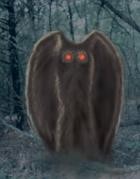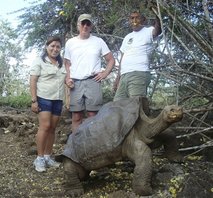From Mothman to G. n. abingdoni
Posted by: Loren Coleman on March 22nd, 2009

Richard Gere who starred in The Mothman Prophecies may be adopting a new cause: the preservation of the Galapagos Islands.
Galapagos National Park spokeswoman Vanessa Garcia says that during a visit to the Ecuadorean islands, he offered to speak out publicly for their conservation.
The Galapagos are home to unique animal and plant species and were a living laboratory for Charles Darwin. But conservationists say they are threatened by development and tourism.

American movie star Richard Gere, center, poses for pictures next to Solitario Jorge, a giant tortoise in the Galapagos Islands, Ecuador, Wednesday, March 18, 2009. The woman at left and the man at right are park guides. (AP Photo)
The 59-year-old star of various movies is touring the archipelago with his wife and son. Ecuadorean TV shows Gere meeting what is believed to be the last living member of the Geochelone nigra abingdoni tortoise species.
Lonesome George (Spanish: Solitario Jorge) is the last known individual of the Pinta Island Tortoise, subspecies Geochelone nigra abingdoni, one of eleven subspecies of Galápagos tortoise native to the Galápagos Islands. He has been labelled the rarest creature in the world, and is a potent symbol for conservation efforts in the Galápagos and internationally. It is thought that he was named after a character played by American actor George Gobel.
George was first seen on the island of Pinta on December 1, 1971 by American snail biologist Joseph Vagvolgyi. The island’s vegetation had been decimated by introduced feral goats, and the indigenous G. n. abingdoni population had been reduced to a single individual. Relocated for his safety to the Charles Darwin Research Station, George was penned with two females of a different subspecies, Geochelone nigra becki from Wolf Island, in the hope that his genotype would be retained in the resulting progeny. Any offspring successfully hatched from George and his consorts would be intergrades, not purebreds of the Pinta subspecies.
George is estimated to be 60–90 years of age, and is in good health. A prolonged effort to exterminate goats introduced to Pinta is now complete and the vegetation of the island is starting to return to its former state.
In May 2007, analysis of genomic microsatellites (DNA sequences) suggested that other individuals of Geochelone nigra abingdoni may still exist. Researchers have identified one male tortoise from the neighboring Galápagos island of Isabela which has half his genes in common with George’s subspecies. This animal must be a first generation intergrade between the subspecies of the islands Isabela and Pinta. It is possible that a pure Pinta tortoise lives among the 2,000 tortoises on Isabela.
Attempts at mating Lonesome George were unsuccessful for several decades, possibly due to the lack of a female of his own subspecies, and prompted researchers at the Darwin Station to offer a $10,000 reward for a suitable mate. On July 21 2008, it was reported that George had unexpectedly mated with one of his female companions. A total of thirteen eggs were collected and placed in incubators. However, on November 11, 2008, The Charles Darwin Research Center reported that 80% of the eggs showed weight loss characteristic of being infertile. To the disappointment of the Darwin Center, by December 2008 the remaining eggs had failed to hatch and x-rays had showed them to be infertile.
Richard Gere is an outspoken advocate for human rights in the Free Tibet movement and other causes.
Remember another cause, be a star yourself, make some time today to have a small impact close to your heart that would be huge in supporting cryptozoology…click below now…
🙂 Thank You.
About Loren Coleman
Loren Coleman is one of the world’s leading cryptozoologists, some say “the” leading living cryptozoologist. Certainly, he is acknowledged as the current living American researcher and writer who has most popularized cryptozoology in the late 20th and early 21st centuries.
Starting his fieldwork and investigations in 1960, after traveling and trekking extensively in pursuit of cryptozoological mysteries, Coleman began writing to share his experiences in 1969. An honorary member of Ivan T. Sanderson’s Society for the Investigation of the Unexplained in the 1970s, Coleman has been bestowed with similar honorary memberships of the North Idaho College Cryptozoology Club in 1983, and in subsequent years, that of the British Columbia Scientific Cryptozoology Club, CryptoSafari International, and other international organizations. He was also a Life Member and Benefactor of the International Society of Cryptozoology (now-defunct).
Loren Coleman’s daily blog, as a member of the Cryptomundo Team, served as an ongoing avenue of communication for the ever-growing body of cryptozoo news from 2005 through 2013. He returned as an infrequent contributor beginning Halloween week of 2015.
Coleman is the founder in 2003, and current director of the International Cryptozoology Museum in Portland, Maine.










How really, is it important in the grand scheme, to preserve each and every evolutionary experiment?
We are almost at the point where we can create completely new designer species. Including variations of our own.
If “Gaia” exists as an entity, WE ARE HER BRAIN!
And the environmentalist movement is her conscience.
As the great canadian philosopher said “We’re all in this together.”
You raise an interesting point Remus, but I personally think that in the interest of the continued proliferation of sentience and life in general, it is best that we preserve as many species as we can, within reason. This would keep evolutionary pathways open, allowing for more bio diversity in general. But I digress, hope that lonesome George isn’t as lonesome as he seems, best wishes to the Darwin Center and all of it’s kin. Thanks for the update Loren!
Intersting article, Loen.
It’s always interesting to me when those who are believers in evolution invariable go against the tenents of evolution. In this case, the preservation of a species which is doomed to extinction. According to evolution, the only way things progress is through the culling of the weak in favor of the strong. Why do we go to such lengths to peserve a species not able to hold its own in nature? Because man introduced a non-native species into the mix? Well, according to evolution, man is just another evolved animal, and thus, if they can’t survive us, they should pass on to make way for us.
All this being said, it’s good we do what we do, when we see a species being destroyed, particularly because man did something stupid like introducing a browsing animal to a place it was sure to destroy, and thus hurt the native species-we shoule attempt to fix the mistakes of our past. But why, if we are just living out evolution? Because, simply, we aren’t. God commanded man to subdue the earth-we are to control it, to a point, but also to be good stewards of it. We don’t worship it, but neither should be allow it to be needlessly damaged. use it, but don’t abuse it. By seeking to preserve the species that can’t survive because of harm we, the caretakers of earth, have done, is the epitomy of obedience to the command to subdue the earth. Another reason to disbelieve evolution, because our very genetic makeup induces us to live against it.
Good article. Hope we can produce more of these tortoises.